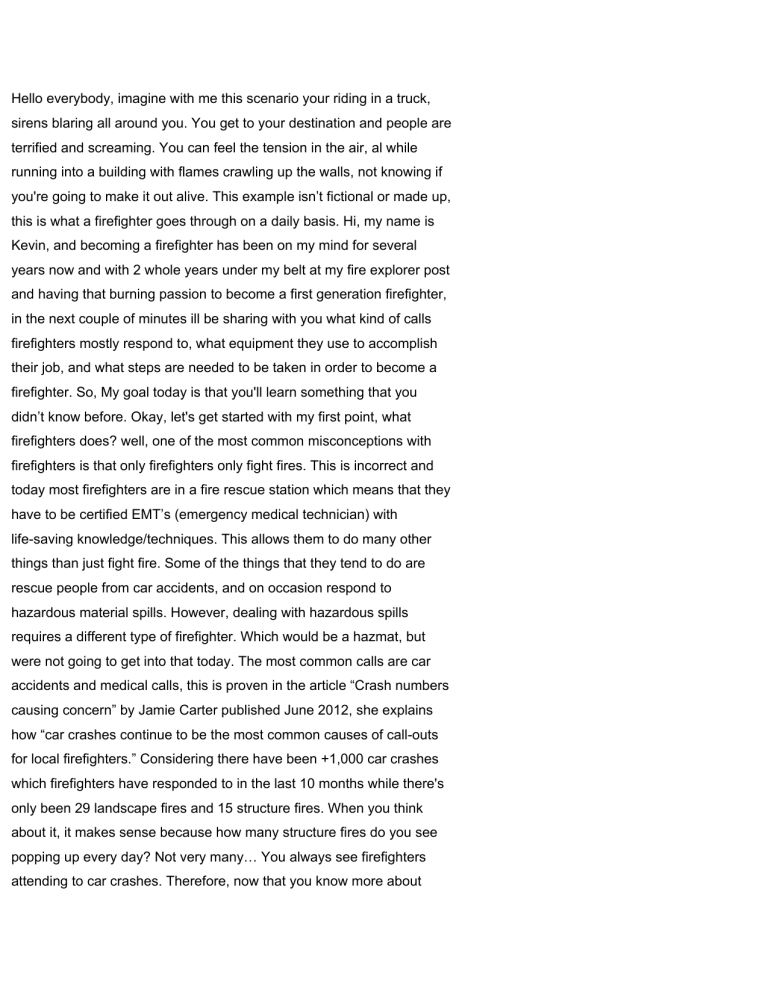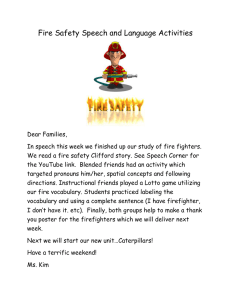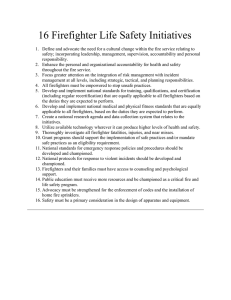
Hello everybody, imagine with me this scenario your riding in a truck, sirens blaring all around you. You get to your destination and people are terrified and screaming. You can feel the tension in the air, al while running into a building with flames crawling up the walls, not knowing if you're going to make it out alive. This example isn’t fictional or made up, this is what a firefighter goes through on a daily basis. Hi, my name is Kevin, and becoming a firefighter has been on my mind for several years now and with 2 whole years under my belt at my fire explorer post and having that burning passion to become a first generation firefighter, in the next couple of minutes ill be sharing with you what kind of calls firefighters mostly respond to, what equipment they use to accomplish their job, and what steps are needed to be taken in order to become a firefighter. So, My goal today is that you'll learn something that you didn’t know before. Okay, let's get started with my first point, what firefighters does? well, one of the most common misconceptions with firefighters is that only firefighters only fight fires. This is incorrect and today most firefighters are in a fire rescue station which means that they have to be certified EMT’s (emergency medical technician) with life-saving knowledge/techniques. This allows them to do many other things than just fight fire. Some of the things that they tend to do are rescue people from car accidents, and on occasion respond to hazardous material spills. However, dealing with hazardous spills requires a different type of firefighter. Which would be a hazmat, but were not going to get into that today. The most common calls are car accidents and medical calls, this is proven in the article “Crash numbers causing concern” by Jamie Carter published June 2012, she explains how “car crashes continue to be the most common causes of call-outs for local firefighters.” Considering there have been +1,000 car crashes which firefighters have responded to in the last 10 months while there's only been 29 landscape fires and 15 structure fires. When you think about it, it makes sense because how many structure fires do you see popping up every day? Not very many… You always see firefighters attending to car crashes. Therefore, now that you know more about what a firefighter does, I can explain the equipment they use to help accomplish their job. Let's start out with turnouts. In the article, “Firefighter Turnout Gear Durability Study—Evaluation of Visibility Trim” by Deena Cotterill* and Elizabeth P. Easter published July 2011, at the University of Kentucky emphasizes how turnouts are a firefighters “first line of defense to minimize the risk of injury in hazardous environments”. As you have seen before firefighters wear protective gear also known as PPE (personal protective equipment). They wear a coat to protect their body, pants to protect their legs, and boots to protect their feet. Which have been designed and reinforced with 3 layers of fabric for specific protective reasons. As well, and most importantly they wear their helmet to protect their heads from falling debris with a hood tucked underneath to protect their neck and ears. They also wear gloves btw haha. Some of the commonly known tools are the axe and halligan which helps firefighters break down doors. When married together the two tools are called a set of Irons. Next, hoses help to put out fires by allowing for water to reach hard to get to areas, and ladders are used to help access 2nd story buildings and higher. They also use sledgehammers to break down doors and walls, all while wearing their breathing apparatus known as an SCBA (self-contained breathing apparatus) which allows them to breathe clean oxygen rather than toxic fumes/gases that can cause cancer. However before a firefighter can begin any of that, they must do what is required to become a firefighter. I’ll now move onto my next point, how to become a firefighter. According to “learnhowtobecome.org” accessed on August 2019, it is required for an applicant to be eight-teen years old, have finished high school, and be physically fit. Obtaining your CPR certification is essential, as well as getting an EMT certification, and have been and completed a “Firefighter 1 Academy”. Through completing all of those requirements, it shows your worth of their time for them to take a look at you. After that, you can go and apply to different departments. From personal experience, as far as testing goes, you need to push yourself to an extreme level when you’re training so that when you go to testing you can surpass the expectations with ease. After that, they will follow up with an interview and depending on how that goes, they’ll give the written exam. The hiring process is very competitive seeing how thousands of applicants are competing for just 3-4 positions sometimes. Learning how to sell yourself is crucial to set yourself apart from the other applicants. If you desire just to be just a basic firefighter, those are the requirements to qualify. However, if you desire to become a Firefighter paramedic like I do, which pays better, you need to then attend paramedic school which requires 120-150 hours of training. It could either take up to about 6 months to 2 years depending on the amount of effort one puts in and consistency. The more time put into this profession to obtain more knowledge, the more valuable you are and the more of an edge you have on your competitors. All in all, seeing how I've talked about what a firefighter does, what equipment they use in order to be quick and efficient at their job, and what it takes to become a firefighter. I hope all of you have grasped a better understanding about firefighting and the hard work and dedication it takes. And if you’ve ever thought about it, go visit your local fire station to get more information… oh and i just wanna put this out there, firefighting isn’t just a man’s job, there are many women in the fire service so if you've ever thought about it ladies, go out and inquire more information! And who knows… maybe we might just see each other out there in the field. Work Cited Writers, S. (2019, April 21). Paramedic Schools & EMT Training: How to Become a Paramedic/EMT. Retrieved from https://www.learnhowtobecome.org/paramedic-emt/ Cotterill, D. text. lab. uky@gmail. co., & Easter, E. P. . (2011). Firefighter Turnout Gear Durability Study-Evaluation of Visibility Trim. Fire Technology, 47(3), 601–613. https://doi.org/10.1007/s10694-010-0189-2 JAMIE-LEIGH CARTER<br/>carterj@qst.newsltd.com.au. (2012). Crash numbers causing concern. Northern Times (Brisbane), 7. Retrieved from http://search.ebscohost.com/login.aspx?direct=true&db=n5h&AN=201206221E 07369642&site=ehost-live


